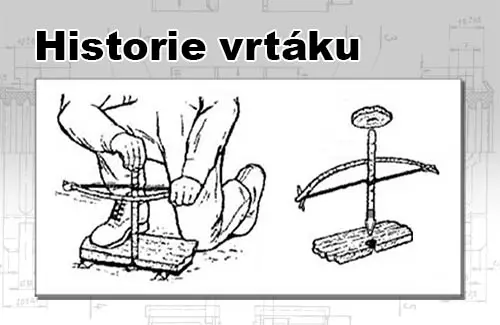The regular price is the current manufacturer's recommended price! FREE shipping for orders over EUR 41,67 within CZ+SK (PPLparcel)

A drill is a very old tool, already in ancient times people used it to dig holes that could not be made with a chisel. In Pakistan, the remains of people whose aching teeth were drilled by a prehistoric dentist using a so-called "flint drill", 5500 - 7000 l. BC. The method consists in clamping the drill to the bowstring, with a simple loop. One hand presses over the bearing (stone) on the drill with a flat tip, which generates an axial force. The other simultaneously moves the bow and thus generates a torque, see. Fig. A similar method can also be used to start a fire, which best illustrates the heat generated during the drilling process.
.jpg)
Drills were later derived from this principle, which were powered for centuries by human power, water wheels, windmills and later by steam engines. The turning point came in 1889, when Arthur James Arnotov, from Melbourne, Australia, built the first electric drill.
The principle of drills remained the same until 1861, when S. A. Morse came up with his idea of a screw drill. This consists of two parallel helical grooves, which are terminated at one end by two cutting edges, and at the other end it passes into a cylindrical clamping shank. On April 7, 1863, Morse applied for his patent with the United States Patent Office under number 38, 119. The invention of the screw drill meant a real revolution in hole drilling technology and soon spread throughout the world.
In modern history, we have many patents and utility models based on the twist drill. In the Czech Republic, the most beneficial in the field of HSS drills is the patent - utility model of the CZ002 and CZ004 drills. These drills have applied variable geometry of the drill core, which has achieved significantly lower sliding forces, and thus lower heat generation, higher stability, greater geometric and dimensional accuracy of the hole with lower surface roughness. The result is a drill that takes up a precise position by tracing (does not dance), allows for more than 2 times the cutting speed compared to conventional drills, is very easy to resharpen, does not require pre-drilling and significantly increases its service life.
More articles:
Testy vrtáků s novou geometrií